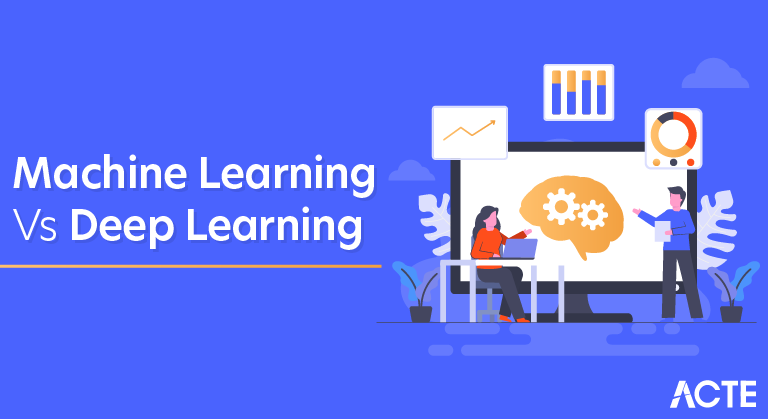
Machine Learning Vs Deep Learning: Which is better?
Last updated on 11th Jul 2020, Blog, General
- The article explains the essential difference between machine learning & deep learning
- Comparison between machine learning & deep learning explained with examples
Machine learning and deep learning in a rage! All of a sudden everyone is talking about them – irrespective of whether they understand the differences or not! Whether you have been actively following data science or not – you would have heard these terms.
Just to show you the kind of attention they are getting, here is the Google trend for these keywords,

If you have often wondered to yourself what is the difference between machine learning and deep learning, read on to find out a detailed comparison in simple layman language. I have explained each of these terms in detail. Then I have gone ahead to compare both of them and explained where we can use them.
Deep learning & Machine learning
Machine learning
Machine learning is a subset of artificial intelligence associated with creating algorithms that can change themselves without human intervention to get the desired result – by feeding themselves through structured data
Solution using Machine learning
To help the machine learning algorithm classify images into collections according to two categories (dog and cat), it needs to present these images first. But how does the algorithm know which one is which?
The answer to this question is the availability of structured data, as described above in the definition of machine learning. You simply mark the images of dogs and cats in order to determine the characteristics of both animals. These data will be sufficient for training a machine learning algorithm, and then he will continue to work on the basis that they understand the markings and klassificeret millions of other images of animals both on the grounds that he had studied earlier.
Deep learning
Deep learning is a subset of machine learning where algorithms are created and function similarly to machine learning, but there are many levels of these algorithms, each providing a different interpretation of the data it conveys. This network of algorithms is called artificial neural networks. In simple words, it resembles the neural connections that exist in the human brain.
Solution using Deep learning
Deep learning neural networks will use a different approach to solve this problem. The main advantage of deep learning is that it doesn’t necessarily need structured/tagged image data to classify two animals. In this case, the input data (image data) is sent through different levels of neural networks, and each network hierarchically determines the specific features of the images.
This is similar to how our human brain works to solve problems – running queries through different hierarchies of concepts and related questions to find the answer.
After processing the data through different levels of neural networks, the system finds appropriate identifiers to classify both animals by their images.
So, in this example, you can see that the machine learning algorithm requires labeled/structured data to understand the differences between images of cats and dogs, study the classification, and then draw a conclusion.
On the other hand, the deep learning network was able to classify the images of both animals from data processed in the layers of the network. This did not require any labeled/structured data, as it relied on different outputs processed by each layer, which were combined to form a single way of classifying images.
Applications of Deep Learning models
Deep Learning models are usually applied to problems that deal with data that do not have a simple row-column structure, like image classification or language translation, as they are great at operating on unstructured and complex-structure data these tasks handle — images, text, and sound. There are problems with handling data of these types and sizes with classical Machine Learning algorithms, and creating and applying some deep neural networks to these problems have caused tremendous developments in the fields of image recognition, speech recognition, text classification, and language translation in the last few years.
Application of Deep Learning to these problems was possible due to the fact that DNNs accept multi-dimensional tables of numbers, called tensors, as both input and output, and can track the spatial and temporal relationships between their elements. For example, we can present an image as a 3-dimensional tensor, where dimension one and two represent the resolution of the digital image (so have the sizes of the image width and height, respectively), and the third dimension represents the RGB color coding of each of the pixels (so the third dimension is of size 3). This allows us to not only represent all the information about the image in a tensor but also keep the spatial relationships between pixels, which turns out to be crucial in the application of so-called convolutional layers, crucial in successful image classification and recognition networks.
Neural network flexibility in the input and output structures helps also in other tasks, like language translation. When dealing with text data, we feed the deep neural networks with number representations of the words, ordered according to their appearance in the text. Each word is represented by a vector of one hundred or a few hundred numbers, computed (usually using a different neural network) so that the relationships between vectors corresponding to different words mimic the relationships of the words themselves. These vector language representations, called embeddings, once trained, can be reused in many architectures, and are a central building block of neural network language models.
The difference between deep learning and machine learning
In practical terms, deep learning is just a subset of machine learning. In fact, deep learning technology is machine learning and functions in a similar way (hence why the terms are sometimes loosely interchanged). However, its capabilities are different.
While basic machine learning models do become progressively better at whatever their function is, they still need some guidance. If an AI algorithm returns an inaccurate prediction, then an engineer has to step in and make adjustments. With a deep learning model, an algorithm can determine on its own if a prediction is accurate or not through its own neural network.
Let’s go back to the flashlight example: it could be programmed to turn on when it recognizes the audible cue of someone saying the word “dark”. As it continues learning, it might eventually turn on with any phrase containing that word. Now if the flashlight had a deep learning model, it could figure out that it should turn on with the cues “I can’t see” or “the light switch won’t work,” perhaps in tandem with a light sensor. A deep learning model is able to learn through its own method of computing—a technique that makes it seem like it has its own brain.
Table of Contents
- What is Machine Learning and Deep Learning?
- What is Machine Learning?
- What is Deep Learning?
- Comparison of Machine Learning and Deep Learning
- Data Dependencies
- Hardware Dependency
- Problem Solving Approach
- Feature Engineering
- Execution time
- Interpretability
- Where is Machine Learning and Deep Learning being applied right now?
- Pop Quiz
- Future Trends
Interesting facts and statistics Deep learning and Machine learning:
- AI specialist salary is equal to the cost of Roll-Royce Ghost Series II 2017 (according to the New York Times);
- Is there a chance of losing your job due to AI progress? According to a recent PwC report – it is possible. They suggest that by about 2030, 38% of all jobs in the US could be replaced by artificial intelligence and automation technology;
- The first AI program “The Logic Theorist” was created in 1955 by Newell & Simon (World Information Organization);
- Researchers predict that by 2020, 85% of customer engagement will be non-human (Gartner);
- The market for artificial intelligence or machine learning will grow to $ 5.05 billion by 2020 (Motley Fool)
what do machine learning and deep learning mean for customer service?
Many of today’s AI applications in customer service utilize machine learning algorithms. They’re used to drive self-service, increase agent productivity, and make workflows more reliable.
The data fed into those algorithms comes from a constant flux of incoming customer queries, which includes relevant context into the issues that customers are facing. Aggregating that context into an AI application, in turn, leads to quicker and more accurate predictions. This has made artificial intelligence an exciting prospect for many businesses, with industry leaders speculating that the most practical applications of business-related AI will be for customer service.

And as deep learning becomes more refined, we’ll see even more advanced applications of artificial intelligence in customer service. A great example is Zendesk’s own Answer Bot, which incorporates a deep learning model to understand the context of a support ticket and learn which help articles it should suggest to a customer.
